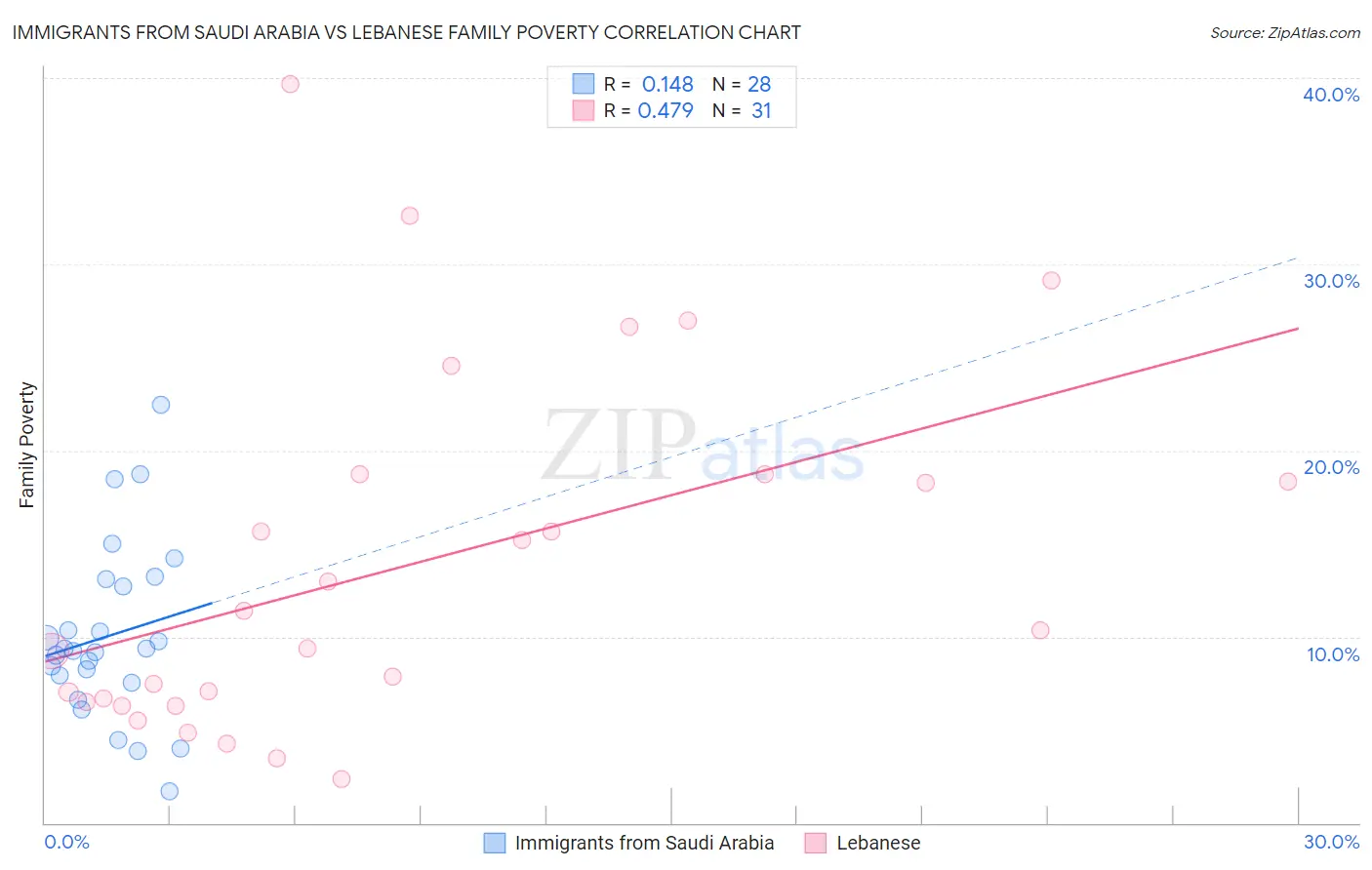Immigrants from Saudi Arabia vs Lebanese Family Poverty
COMPARE
Immigrants from Saudi Arabia
Lebanese
Family Poverty
Family Poverty Comparison
Immigrants from Saudi Arabia
Lebanese
9.1%
FAMILY POVERTY
38.6/ 100
METRIC RATING
185th/ 347
METRIC RANK
8.9%
FAMILY POVERTY
57.6/ 100
METRIC RATING
171st/ 347
METRIC RANK
Immigrants from Saudi Arabia vs Lebanese Family Poverty Correlation Chart
The statistical analysis conducted on geographies consisting of 164,117,419 people shows a poor positive correlation between the proportion of Immigrants from Saudi Arabia and poverty level among families in the United States with a correlation coefficient (R) of 0.148 and weighted average of 9.1%. Similarly, the statistical analysis conducted on geographies consisting of 400,253,340 people shows a moderate positive correlation between the proportion of Lebanese and poverty level among families in the United States with a correlation coefficient (R) of 0.479 and weighted average of 8.9%, a difference of 2.5%.

Family Poverty Correlation Summary
| Measurement | Immigrants from Saudi Arabia | Lebanese |
| Minimum | 1.7% | 2.3% |
| Maximum | 22.5% | 39.7% |
| Range | 20.8% | 37.3% |
| Mean | 10.1% | 13.8% |
| Median | 9.3% | 10.4% |
| Interquartile 25% (IQ1) | 7.7% | 6.5% |
| Interquartile 75% (IQ3) | 12.9% | 18.7% |
| Interquartile Range (IQR) | 5.2% | 12.2% |
| Standard Deviation (Sample) | 4.7% | 9.5% |
| Standard Deviation (Population) | 4.6% | 9.4% |
Demographics Similar to Immigrants from Saudi Arabia and Lebanese by Family Poverty
In terms of family poverty, the demographic groups most similar to Immigrants from Saudi Arabia are South American Indian (9.1%, a difference of 0.010%), Uruguayan (9.1%, a difference of 0.080%), Immigrants from Morocco (9.1%, a difference of 0.21%), Hmong (9.1%, a difference of 0.22%), and Colombian (9.2%, a difference of 0.35%). Similarly, the demographic groups most similar to Lebanese are Immigrants from Peru (8.9%, a difference of 0.010%), Kenyan (8.9%, a difference of 0.080%), Immigrants from Fiji (8.9%, a difference of 0.16%), Immigrants from Chile (8.9%, a difference of 0.27%), and Israeli (8.9%, a difference of 0.62%).
| Demographics | Rating | Rank | Family Poverty |
| Israelis | 62.1 /100 | #168 | Good 8.9% |
| Immigrants | Chile | 59.6 /100 | #169 | Average 8.9% |
| Kenyans | 58.2 /100 | #170 | Average 8.9% |
| Lebanese | 57.6 /100 | #171 | Average 8.9% |
| Immigrants | Peru | 57.5 /100 | #172 | Average 8.9% |
| Immigrants | Fiji | 56.4 /100 | #173 | Average 8.9% |
| Immigrants | Albania | 50.0 /100 | #174 | Average 9.0% |
| Costa Ricans | 49.3 /100 | #175 | Average 9.0% |
| Immigrants | Syria | 47.5 /100 | #176 | Average 9.0% |
| Hawaiians | 47.2 /100 | #177 | Average 9.0% |
| Immigrants | Cameroon | 47.1 /100 | #178 | Average 9.0% |
| Immigrants | Iraq | 44.4 /100 | #179 | Average 9.1% |
| Immigrants | Uganda | 43.4 /100 | #180 | Average 9.1% |
| Hmong | 40.2 /100 | #181 | Average 9.1% |
| Immigrants | Morocco | 40.2 /100 | #182 | Average 9.1% |
| Uruguayans | 39.2 /100 | #183 | Fair 9.1% |
| South American Indians | 38.7 /100 | #184 | Fair 9.1% |
| Immigrants | Saudi Arabia | 38.6 /100 | #185 | Fair 9.1% |
| Colombians | 36.1 /100 | #186 | Fair 9.2% |
| Delaware | 35.4 /100 | #187 | Fair 9.2% |
| Immigrants | Kenya | 34.0 /100 | #188 | Fair 9.2% |